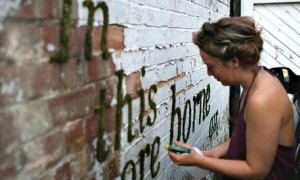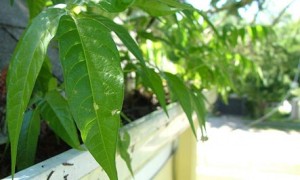1. Moss Graffiti
Decorate your garden in beautiful moss! You can use moss graffiti to adorn a wall, like in the image above, or on stepping stones or wooden or ceramic planters. Spring rains will help that moss thrive. What a unique way to add more personality to your springtime garden!
I just love a DIY urban beautification project! Whether we’re talking about Kintta’s yarn graffiti or using seedbombs to spread greenery to blighted spaces, I’m struck by how much a little color can impact the urban landscape. Moss graffiti definitely falls under this umbrella.
Unlike spray paint, moss graffiti is all natural and healthy to work with. You can paint words or images, and the moss fills in like magic! It’s easy as pie to whip up a batch of moss paint. Here’s how:
What You’ll Need:
- Handfulls of Moss
- 1-2 Tablespoons Sugar
- 1/2 cup Buttermilk
- Water
- Blender
- Covered Container
- Paint Brush
- Chalk
- Spray Mist Bottle
What To Do:
- Collect moss.
- Clean the dirt off the moss.
- Sketch out the image onto the surface with chalk.
- Place moss in the blender.
- Add sugar and buttermilk
- Blend until thick like a milkshake. If it gets too thick, add some water.
- Pour into container.
- With the paintbrush, create your design on the surface.
- Leftover moss can be stored in the refrigerator and reapplied if needed.
- Spray your moss wall art daily with water.
- The design should start to spread over the area.
Here is another recipe from Stories From Space that uses beer instead of buttermilk.
You can use a brush to paint your moss onto concrete walls, rocks, or brick. Mist the moss once a day to help it thrive, and soon your green graffiti will take hold! If you’re looking to take this project to the streets, use caution- we don’t want to be responsible for any vandalism charges!
Another natural wonder found along Adirondack trails is moss. This lush plant rises in moist places and cushions the rock faces that anchor the forest floor. Moss is beautiful to look at, but did you know moss can be painted with too?
Images of moss wall art graffiti have been making the rounds of the blogosphere for a while now. Every time images of moss graffiti pop up on my computer screen, I find it delightfully whimsical to see the words and murals painted with moss. It’s the ultimate garden wallpaper. Moss graffiti can be spray-painted onto a surface. It creates a naturally organic paint, as opposed to traditional enamel based aerosol sprays. If you love the look of moss graffiti, try this recipe (adapted from this Apartment Therapy post):
2. Vertical Garden From Reclaimed Gutters
We recently posted a story on Suzanne Forsling’s brilliant gutter garden. The below is an except from the story
“There is only one side of our house that gets much sunshine, and, of course, that side of the house has the smallest yard. It is really just an alleyway between ours and the neighbors. I might eventually put in some cold frames, but can’t really afford that this year with all the extra money going to the high energy and food prices.
So my brain has kept working the issue, even while I was asleep. One morning in late May, I woke up with an idea that seems to be a real solution for our situation, and I thought it might help others as well. I had heard about people using rain gutters around deck railing at a master gardener class that I took this past spring from the Cooperative Extension Service.
But our deck is on the wrong side of the house. Then an idea came to me that was a little unusual and might involve a little risk. The idea is essential this: Why not put rain gutters in rows along the wood siding on the sunny side of the house. It might look weird, but that was where all the heat, sun and protection from damage is best. I talked to my husband, Pete, about it and he agreed it was worth a try.
We went to Home Depot and selected some “attractive” brown plastic gutters along with all the required parts so that we could mount them in one long row. (The total length or a row would be about 20 feet). Pete drilled some very small holes in the bottom of the gutters to let excess water drain out after he mounted them on the siding.
I filled the gutters with Miracle Grow Garden Soil to about half full. I put in some time release fertilizer and added the other half of the soil (the extra fertilizer was needed because I knew that frequent watering would drain out the nutrients quickly).
I packed the soil in firmly since the plants wouldn’t have a lot of it to grow in. Then I put the seeds in and watered it well. I also allowed water to run down the back side of the gutters (on the siding side) this time only, so that any soil left would be in the gutters and not hidden behind them to cause damage to the siding.”
3. DIY Garden Markers
5 ways to make your own garden markers
1. Pottery shards are perfect to label your herbs and veggies. (If you don’t have any broken pots, I recommend Goodwill, or our cats would be happy to come over to break some for you.)
2. Find some children to collect flat rocks for you. Wash them thoroughly, and then use paint or markers to decorate them and mark them with veggie names. Use a couple coats of polyurethane or clear spray paint to seal.
3. For artsy garden markers, raid your local thrift shop for old silverware. Find some with cool, mismatched handles, and write your labels with a sharpie on the metal. In scientific testing I performed, permanent marker holds up to water but not hard scrubbing, so you should be able to reuse your cutlery again and again. (Good. I don’t know how to grow mulch.)This at least is truth in advertising.If you prefer something simpler, use white plastic cutlery. It looks neat, photographs much better, and stands out in a garden.
4. Use scissors to cut the top and bottom off of an aluminum soda or beer can. Cut the can into strips. You can either cut these into regular-shaped garden markers (rounded on one side, pointy on the other), or you can create whatever shape you want, hole punch it, and hang it with wire.Chances are, this sign is too illegible to mislead you. You can try to “engrave” your plant names on to the aluminum, but I had limited patience/success with that, because even using a nail, the words didn’t show up very well. But permanent marker looked fine.
5. Oh, your cats also chewed and destroyed your blinds? Before you throw them away, salvage what you can! Scissors and a permanent marker will make these into perfect plant markers.
4. Build a Compost Bin
Do you want to limit the amount of trash you produce and help make your backyard soil healthy and productive? One of the easiest solutions to these problems is to compost your food waste. It requires little personal energy, and you will benefit from the rich compost that’s created from the breakdown of your kitchen scraps.
The only thing you really need to do is create a suitable bin for your soon-to-be compost. There are alternatives to the overpriced, plastic compost containers that some garden supply stores sell to customers. You can make your own bin using recycled shipping pallets for less than 20 dollars, or even free if you have some of the few necessary supplies.
Why to build with shipping pallets?
-Approximately 40 percent of all hardwood harvested in the U.S. is used for making shipping pallets.
-About two-thirds of pallets are used only once before being thrown out.
-1/4 of all wood in landfills is from used pallets.
Why not put some of those shipping pallets headed to the landfill to good use? You can easily find shipping pallets around your town or city; try contacting supermarkets, warehouses, and other businesses that regularly receive large shipments.
5. Make an Upside-Down Tomato Planter
Tomatoes and other vines grow very well in upside-down containers. Upside down hanging planters also help maximize a small space, so that you can grow more food in less square footage. In the video above, The Tired Garden Test Beds shows you how to create a simple upside down planter using a bucket, a coffee filter, and a utility knife.
6. Build a Self-Watering Container
One of the best parts about making self-watering containers for your garden is that it’s cheap. Most of the supplies needed are either already laying around the house or you can easily get in your neighborhood.
There are four ways that you can make a self-watering container — using two containers with no pipe, using two containers with pipe, using a 2 liter soda bottle and using vinyl tile.
Container Within A Container and No Pipe
- Tools
- Drill
- 1/4? bit
- 3 1/2? hole saw for metal and wood
- 1 1/4? hole saw for metal and wood
Materials:
- 2 food grade 5 gallon containers — 1 for planting container and 1 for reservoir container
- 1/2 deli container for wicking basket
- Instructions On How to Make With 2 Containers and No Pipe
- Use the 1/4? drill bit to drill holes in the deli container.
- Attach the 3 1/2? hole saw attachment to the drill. Drill a hole in the bottom of the container. I’ve found drilling in a counter-clockwise direction to work best.
- Reattach the 1/4? drill bit and drill holes in the bottom of the planting container to allow for drainage.
- Put the wicking basket in the middle of the reservoir container.
- Place the planting container in the reservoir container aligning the wicking basket with the hole in the middle.
- There will be a little space between the wicking basket and the planting container. You can duct tape the basket to the bottom of the container, but it’s not necessary.
- Hold the containers up to the light. You should be able to see through the reservoir container where the planting container is. Using the 1 1/4? hole saw, drill a hole 1/4? in the reservoir container below where the planting container is.
- This is the hole where you will water the plant from.
- That’s it. You’re done!
Container Within A Container With Pipe
Tools
- Drill
- 1/4? bit
- 3 1/2? hole saw for metal and wood
- 1 1/4? hole saw for metal and wood
Materials:
- 2 food grade 5 gallon containers — 1 for planting container and 1 for reservoir container
- 1/2 deli container for wicking basket
- Pipe cut to the height of the container
Instructions On How to Make With 2 Containers With Pipe
- Use the 1/4? drill bit to drill holes in the deli container.
- Attach the 3 1/2? hole saw attachment to the drill. Drill a hole in the bottom of the container. I’ve found drilling in a counter-clockwise direction to work best.
- Attach the 1 1/4? hole saw. Drill a hole close to the edge of the container.
- Reattach the 1/4? drill bit and drill holes in the bottom of the planting container to allow for drainage.
- Put the wicking basket in the middle of the reservoir container.
- Place the planting container in the reservoir container aligning the wicking basket with the hole in the middle.
- There will be a little space between the wicking basket and the planting container. You can duct tape the basket to the bottom of the container, but it’s not necessary.
- Hold the containers up to the light. You should be able to see through the reservoir container where the planting container is. Using a 1/4? drill bit, drill a hole 1/4? in the reservoir container below where the planting container is.
- Put the pipe through the planting container to reach the reservoir container. The pipe will have some wiggle room and wont’ be snug. It’s ok. You can duct tape if you’d like.
- That’s it. You’re done!
Article sources:

If you've ever found value in our articles, we'd greatly appreciate your support by purchasing Mindful Meditation Techniques for Kids - A Practical Guide for Adults to Empower Kids with the Gift of Inner Peace and Resilience for Life.
In the spirit of mindfulness, we encourage you to choose the paperback version. Delve into its pages away from screen glare and notifications, allowing yourself to fully immerse in the transformative practices within. The physical book enriches the learning process and serves as a tangible commitment to mindfulness, easily shared among family and friends.
Over the past few years, Wake Up World has faced significant online censorship, impacting our financial ability to stay online. Instead of soliciting donations, we're exploring win-win solutions with our readers to remain financially viable. Moving into book publishing, we hope to secure ongoing funds to continue our mission. With over 8,500 articles published in the past 13 years, we are committed to keeping our content free and accessible to everyone, without resorting to a paywall.










